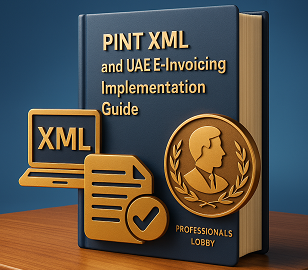The United Arab Emirates will begin mandatory e‑invoicing from July 2026 using a decentralized Peppol-based five‑corner model. The document format for exchanging invoices will be the Peppol International Invoice (PINT) in XML. This comprehensive guide from Professionals Lobby explains everything UAE businesses need to know about PINT XML implementation, from technical requirements to impact on accounting processes.
Executive Summary: Vendors and finance teams must update their systems to generate, receive, validate, exchange, and archive PINT‑compliant invoices and credit notes and to report tax data to the Federal Tax Authority (FTA) via accredited service providers.
Quick Navigation
What is PINT XML?
PINT stands for Peppol International Invoice. It is a global Peppol specification for e‑invoices and credit notes that:
- Uses XML syntax based on UBL 2.1 for Invoice and CreditNote documents
- Harmonises core data elements from the EU EN 16931 model (Peppol BIS Billing 3.0) with additional international requirements
- Ensures interoperability across countries so that senders/receivers need minimal country‑specific extensions
PINT Document Types
- Invoice (Invoice-2.1)
- CreditNote (CreditNote-2.1)
- Envelope: SBDH (Standard Business Document Header) is commonly used for routing and context
PINT XML Structure Example
<Invoice xmlns="urn:oasis:names:specification:ubl:schema:xsd:Invoice-2">
<cbc:CustomizationID>urn:fdc:peppol.eu:poacc:trns:billing:3.0:pint:1.0</cbc:CustomizationID>
<cbc:ProfileID>urn:fdc:peppol.eu:poacc:bis:billing:3</cbc:ProfileID>
<cbc:ID>INV-2025-000123</cbc:ID>
<cbc:IssueDate>2025-08-31</cbc:IssueDate>
<cac:AccountingSupplierParty>
<cac:Party>
<cbc:EndpointID schemeID="PEPPOL">0088:123456789</cbc:EndpointID>
<cac:PartyTaxScheme><cbc:CompanyID>100000123400003</cbc:CompanyID></cac:PartyTaxScheme>
<cac:PartyLegalEntity><cbc:RegistrationName>ABC Trading LLC</cbc:RegistrationName></cac:PartyLegalEntity>
</cac:Party>
</cac:AccountingSupplierParty>
<cac:AccountingCustomerParty>
<cac:Party>
<cbc:EndpointID schemeID="PEPPOL">0088:998877665</cbc:EndpointID>
<cac:PartyTaxScheme><cbc:CompanyID>100000987600005</cbc:CompanyID></cac:PartyTaxScheme>
<cac:PartyLegalEntity><cbc:RegistrationName>XYZ LLC</cbc:RegistrationName></cac:PartyLegalEntity>
</cac:Party>
</cac:AccountingCustomerParty>
<cac:TaxTotal>
<cbc:TaxAmount currencyID="AED">50.00</cbc:TaxAmount>
</cac:TaxTotal>
<cac:LegalMonetaryTotal>
<cbc:PayableAmount currencyID="AED">350.00</cbc:PayableAmount>
</cac:LegalMonetaryTotal>
<cac:InvoiceLine>
<cbc:ID>1</cbc:ID>
<cbc:InvoicedQuantity unitCode="EA">5</cbc:InvoicedQuantity>
<cbc:LineExtensionAmount currencyID="AED">300.00</cbc:LineExtensionAmount>
<cac:Item><cbc:Name>Printer Cartridge</cbc:Name></cac:Item>
<cac:Price><cbc:PriceAmount currencyID="AED">60.00</cbc:PriceAmount></cac:Price>
</cac:InvoiceLine>
</Invoice>Note: IDs, URNs and schemeIDs are illustrative; use the latest production identifiers published by Peppol/UAE.
UAE E-Invoicing Mandate
The UAE has chosen a Peppol‑based, decentralized "5‑corner" Continuous Transaction Controls & Exchange (CTC/E) model.
Supplier
Creates invoice in their ERP/accounting system
Supplier ASP
Validates invoice against UAE Data Dictionary and ensures PINT conformance
Peppol Network
Exchanges invoice via Access Points using AS4 protocol
Customer ASP
Receives and validates invoice, delivers to customer
FTA
ASPs report required tax data to Federal Tax Authority
Key Implications for UAE Businesses:
- Businesses must produce/consume PINT XML invoices and credit notes
- Trading partners need Peppol endpoints (Peppol IDs) via their ASPs
- Validation occurs before exchange; non‑conformant invoices are rejected
- All tax data must be reported to FTA through accredited service providers
Implementation Timeline
Q4 2025
Pilot program begins with selected large businesses
Q1 2026
Technical specifications finalized, ASP onboarding
July 2026
Mandatory e-invoicing begins for large businesses
January 2027
Mandatory for all businesses subject to VAT
How PINT Connects to Peppol
Peppol is the network and rulebook; PINT is the billing payload. Understanding this relationship is crucial for successful implementation.

Peppol provides the network infrastructure while PINT defines the invoice content standard
Key Technical Relationships
- PINT builds on Peppol BIS Billing 3.0 - A CIUS (Core Invoice Usage Specification) of EN 16931, with additional international fields/constraints
- Transport uses AS4 - Via Access Points for secure message exchange
- Routing uses SML/SMP - With the participant's Peppol ID for correct delivery
- SBDH header enables routing - Contains metadata for correct processing and delivery
Professionals Lobby Insight:
"The separation between network (Peppol) and content (PINT) means businesses can future-proof their implementations. While Peppol provides the transport mechanism today, PINT XML documents could potentially be exchanged through other channels in the future while maintaining compliance."
What Software Providers Should Know
ERP, accounting software vendors, and implementation partners need to understand the technical and functional requirements for PINT compliance.
Functional Scope
Outbound (AR)
Create, validate, sign, envelop, and send PINT Invoice/CreditNote; receive delivery acknowledgements
Inbound (AP)
Receive, validate, match (2‑/3‑way), post to ledgers, manage exceptions, archive
Reporting
Ensure ASP submits all tax data fields to FTA; reconcile acknowledgements
Technical Essentials
- Schemas: UBL 2.1 for Invoice/CreditNote. Include CustomizationID and ProfileID for PINT
- Identifiers: Support Peppol ID formats and UAE VAT number capture
- Code lists: Currency (ISO 4217), Unit codes (UN/ECE), Tax categories (e.g., S, Z, E, O with UAE rates)
- Validation: Implement syntax (XSD), semantic (Schematron/CIUS), and UAE data dictionary rules
- Security: AS4 messaging via ASP; TLS, certificates, non‑repudiation evidence
- Archiving: Retention per UAE VAT requirements; store original XML, acknowledgements, hashes, and audit trail
Data Model Highlights (Minimum Set)
Parties Information
Supplier/Customer legal names, registration IDs, VAT IDs, addresses
Commercial Details
PO references, contract details, delivery notes, payment terms, bank details
Tax Information
Tax category/rate per line, exemptions (reason codes), totals
Monetary Details
Allowance/charges, line extension, tax totals, payable amount
Logistics (if applicable)
Delivery dates, locations, shipment references
Impact on Accounting Operations
The transition to PINT XML e-invoicing will significantly impact both Accounts Receivable and Accounts Payable processes.
Accounts Receivable (Sales Invoices)
Invoice Creation
AR must capture structured data required by PINT. Free‑text narratives should move to references/notes.
Pricing/Discounts
Represented as Allowance/Charge elements at line/document level with proper reason codes.
Tax Determination
Correct tax category (e.g., standard‑rated, zero‑rated, exempt) and rate per line.
Credit Notes
Must reference the original invoice ID and reason; ensure reversal logic matches PINT requirements.
Rejections
Non‑compliant XML, invalid codes, or failed business rules will bounce before customer receives the invoice—impacting DSO.
Accounts Payable (Vendor Bills)
AP Ingestion
Convert incoming PINT XML into AP vouchers; eliminate OCR processing for structured invoices.
3‑Way Match
Use PO and receipt references in PINT (OrderReference, DespatchLineReference) for automated matching.
Tax Posting
Map tax lines/categories into tax ledgers; validate supplier VAT IDs automatically.
Duplicate Control
Use invoice number/date/supplier ID/hash to block duplicates before posting.
Posting Automation
High‑confidence invoices post straight‑through; exceptions go to a work queue for manual review.
Critical Consideration:
"The shift to PINT XML requires rethinking master data management. Inaccurate supplier/customer data, incorrect tax codes, or missing Peppol IDs will result in failed transactions. Businesses should start data cleansing now to avoid disruption when the mandate takes effect."
Mapping Guide (ERP ⇄ PINT/UBL)
Use this field-by-field mapping as a starting point for your PINT XML implementation. Note that the actual UAE data dictionary may add additional constraints.
| Business Field | ERP Source | PINT/UBL Element | Notes |
|---|---|---|---|
| Customization/Profile | System constants | cbc:CustomizationID, cbc:ProfileID | Use the official PINT URNs for production |
| Supplier VAT / TRN | Supplier master | cac:AccountingSupplierParty/cac:Party/cac:PartyTaxScheme/cbc:CompanyID | UAE TRN format; include scheme if required |
| Supplier Peppol ID | ASP/Onboarding | cbc:EndpointID @schemeID | e.g., 0088:nnnnn…; schemeID as per Peppol list |
| Buyer VAT / TRN | Customer master | cac:AccountingCustomerParty/.../cbc:CompanyID | Validate length/format |
| Buyer Peppol ID | Customer master | cbc:EndpointID | Required for routing |
| Invoice Number | AR invoice | cbc:ID | Unique per supplier |
| Invoice Date | AR invoice | cbc:IssueDate | ISO YYYY-MM-DD |
| PO Number | Sales order | cac:OrderReference/cbc:ID | Important for AP matching |
| Payment Terms | AR | cac:PaymentTerms/cbc:Note or structured terms | Consider days/discounts if supported |
| Currency | AR header | @currencyID on amounts | ISO 4217 (AED, USD, etc.) |
| Line Qty | AR line | cbc:InvoicedQuantity @unitCode | Use UN/ECE codes (e.g., EA) |
| Unit Price | AR line | cac:Price/cbc:PriceAmount | Net price before tax |
| Discount | AR line/doc | cac:AllowanceCharge | Use ChargeIndicator=false; state reason code |
| Tax Category | Tax engine | cac:TaxCategory/cbc:ID | e.g., S, Z, E, O; include rate |
| Tax Amounts | Tax engine | cac:TaxTotal | Header and per‑line totals |
| Payable Amount | AR totals | cac:LegalMonetaryTotal/cbc:PayableAmount | Must equal lines + charges − discounts + tax |
| Bank Details | AR/Payments | cac:PaymentMeans/cac:PayeeFinancialAccount | Optional but useful |
| Original Invoice Ref (for CN) | Credit memo | cac:BillingReference/cac:InvoiceDocumentReference/cbc:ID | Mandatory for credit notes |
Implementation Tip:
"Create a validation framework that checks both syntactic correctness (XSD validation) and semantic rules (business logic) before attempting to send invoices. This will reduce rejection rates and improve processing efficiency."
Implementation Challenges (and Mitigations)
Implementing PINT XML e-invoicing presents several challenges that businesses should anticipate and address proactively.
Identifier Quality (Peppol IDs, TRNs)
Onboarding and master‑data cleansing are critical. Inaccurate identifiers will cause delivery failures and compliance issues.
Mitigation: Enforce ID validation during customer/vendor creation; verify with ASP before first exchange.
Tax Category Correctness
Wrong category or missing reason codes for zero/exempt lines cause rejections and potential compliance penalties.
Mitigation: Centralize tax logic; maintain a UAE ruleset in the tax engine with regular updates.
Unit Codes and Code Lists
Non‑standard or local unit codes fail validation and prevent invoice processing.
Mitigation: Map all UOMs to UN/ECE; lock code lists in ERP to prevent unauthorized changes.
Allowance/Charge Modeling
Discounts/surcharges must be explicit and correctly signed with appropriate reason codes.
Mitigation: Standardize discount types and map to AllowanceCharge with clear reasons in a centralized catalog.
Reference Integrity
Missing PO/contract/delivery references reduces AP automation potential and increases manual processing.
Mitigation: Enforce reference capture in sales and logistics flows; add mandatory controls in AR forms.
Change Management
Sales/AP teams accustomed to PDFs will need new processes and training for electronic invoicing.
Mitigation: Train users early; provide dashboards for e‑invoice status and exceptions with clear resolution paths.
Multi‑ERP Landscapes
Consolidating PINT across group companies adds complexity with different systems and processes.
Mitigation: Use a central e‑invoicing gateway/adapter pattern and a common mapping library across the organization.
Testing Strategy & Scenarios
A comprehensive testing strategy is essential for successful PINT XML implementation. Here's a structured approach to testing.
Testing Environments
ERP Unit Tests
Validate XML generation per line scenarios, totals, and tax calculations within the ERP system
Integration Tests
Test end-to-end flow from ERP to ASP, including connectivity, security, and data integrity
User Acceptance Tests
Validate business processes with real users, exception handling, and reporting
Key Testing Scenarios
Basic Invoice Validation
TS-001Objective: Verify that a simple standard-rated invoice generates valid PINT XML
Test Data: Single line item, 5% VAT, no discounts, AED currency
Validation Points: XSD compliance, correct tax calculations, mandatory elements present
Multi-Currency Invoice
TS-002Objective: Ensure non-AED invoices handle currency conversion and reporting correctly
Test Data: USD invoice with exchange rate information
Validation Points: Currency codes, exchange rate elements, dual currency amounts
Credit Note Processing
TS-003Objective: Validate credit notes reference original invoices correctly
Test Data: Full and partial credit notes with different reason codes
Validation Points: Reference to original invoice, correct sign reversal, reason codes
Tax Exemption Handling
TS-004Objective: Ensure zero-rated and exempt transactions include appropriate reason codes
Test Data: Export invoices, exempt categories (education, healthcare)
Validation Points: Tax category codes, exemption reasons, evidence references
Peppol ID Resolution
TS-005Objective: Verify correct routing based on Peppol ID and SMP lookup
Test Data: Valid and invalid Peppol IDs, different participant schemes
Validation Points: SMP lookup success, correct endpoint resolution, error handling
Testing Best Practice:
"Create a test catalog of invoices that represent your business scenarios - different product types, tax treatments, payment terms, and special cases. Use this catalog for regression testing whenever system changes occur to ensure ongoing compliance."
Conclusion
The UAE's move to mandatory e-invoicing using PINT XML represents a significant shift in how businesses manage their billing processes. While the transition requires investment in system changes and process updates, it also offers substantial benefits in terms of automation, compliance, and operational efficiency.
Successful implementation requires a structured approach:
- Start early with data cleansing and system assessment
- Engage with accredited service providers for guidance
- Develop comprehensive testing scenarios
- Train staff on new processes and exception handling
- Implement monitoring and reconciliation processes
Businesses that approach PINT XML implementation strategically will not only achieve compliance but also position themselves for more efficient financial operations in the digital economy.
Need Help with PINT XML Implementation?
Professionals Lobby offers comprehensive consulting services for UAE businesses preparing for e-invoicing compliance. Contact our experts for assistance with system assessment, implementation planning, and testing strategy development.
